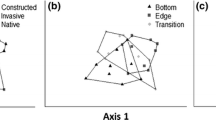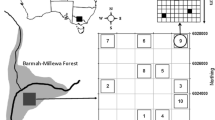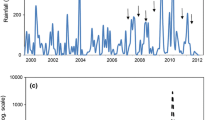Abstract
The existence of a dormant “bank” of plant seeds plays an important role in maintaining and preserving species and genetic diversity. However, information on the spatial heterogeneity of the pool of dormant seeds among wetland complexes along riverine systems is limited. In this study we collected sediment from 18 wetlands within six wetland complexes along the Murray River, Australia. The germinable, residual and viable seed banks in each wetland complex were assessed by undertaking a germination trial, counting seeds (morphotypes) and viability testing. A diverse and viable seed bank exists within all the complexes however seed bank communities differed among wetland complexes. There was no difference in the viability of seeds within the sediment profile, however more seeds occurred in the surface layers of sediment and communities differed with sediment profile depth. In general, the number of species germinating was fewer than the number of seed morphotypes counted. Management actions need to be targeted not only at preserving the extant plant communities but also to ensure the seed bank is replenished. This may also involve allowing wetlands to dry sufficiently to enable cracking of wetland sediment and seeds to become buried to maximise the longevity of the seed store.



Similar content being viewed by others
References
Alexander P, Nielsen DL, Nias D (2008) Response of wetland plant communities to inundation within floodplain landscapes. Ecol Manag Restor 9:187–195
Anderson MJ, Gorley RN, Clarke KR (2008) Permanova+ for Primer: guide to software and statistical methods. PRIMER-E, Plymouth
Andersson E, Nilsson C (2002) Temporal variation in the drift of plant litter and propagules in a small boreal river. Freshw Biol 47:1674–1684
Barrett R, Nielsen DL, Croome R (2010) Associations between the plant communities of floodplain wetlands, water regime and wetland type. River Res Appl 26:866–876
Baskin CC, Baskin JM (2001) Seeds: ecology, biogeography and evolution of dormancy and germination. Cambridge University Press, Cambridge
Bernhardt KG, Koch M, Kropf M, Ulbel E, Webhofer J (2008) Comparison of two methods characterising the seed bank of amphibious plants in submerged sediments. Aquat Bot 88:171–177
Bissels S, Donath TW, Hölzel N, Otte A (2005) Ephemeral wetland vegetation in irregularly flooded arable fields along the northern Upper Rhine: the importance of persistent seedbanks. Phytocoenologia 35:2–3
Boedeltje G, Bakker JP, Bekker RM, Van Groenendael JM, Soesbergen M (2003) Plant dispersal in a lowland stream in relation to occurrence and three specific life-history traits of the species in the species pool. J Ecol 91:855–866
Boedeltje GER, Bakker JP, Ten Brinke A, Van Groenendael JM, Soesbergen M (2004) Dispersal phenology of hydrochorous plants in relation to discharge, seed release time and buoyancy of seeds: the flood pulse concept supported. J Ecol 92:786–796
Bonis A, Lepart J, Grillas P (1995) Seed bank dynamics and coexistence of annual macrophytes in a temporary and variable habitat. Oikos 74:81–92
Boulton AJ, Brock MA (1999) Australian freshwater ecology: processes and management. Gleneagles Publishing, Glen Osmond SA
Brock MA (2011) Persistence of seed banks in Australian temporary wetlands. Freshw Biol 56:1312–1327
Brock MA, Theodore K, O’Donnell L (1994) Seed-bank methods for Australian wetlands. Aust J Mar Freshw Res 45:483–493
Brock MA, Nielsen DL, Shiel RJ, Green JD, Langley JD (2003) Drought and aquatic community resilience: the role of eggs and seeds in sediments of temporary wetlands. Freshw Biol 48:1207–1218
Brock MA, Nielsen DL, Crosslé K (2005) Changes in biotic communities developing from freshwater wetland sediments under experimental salinity and water regimes. Freshw Biol 50:1376–1390
Brown D (1992) Estimating the composition of a forest seed bank: a comparison of the seed extraction and seedling emergence methods. Can J Bot 70:1603–1612
Burmeier S, Donath TW, Otte A, Eckstein RL (2010a) Rapid burial has differential effects on germination and emergence of small- and large-seeded herbaceous plant species. Seed Sci Res 20:189–200
Burmeier S, Eckstein RL, Otte A, Donath T (2010b) Desiccation cracks act as natural seed traps in flood-meadow systems. Plant Soil 333:351–364
Campbell C, Nielsen D (2014) Understanding the effects of alterations to hydrological connectivity on the composition of aquatic and floodplain plant communities. The role of hydrological and riparian connectivity in maintaining biodiversity of river-floodplain ecosystems. Final Report prepared for Department of Environment’s National Environmental Research Program by the MDFRC and CSIRO, MDFRC Publication 38/2014, April, 245 pp, pp 51–68
Campbell CJ, Johns CV, Nielsen DL (2014) The value of plant functional groups in demonstrating and communicating vegetation responses to environmental flows. Freshw Biol 59:858–869
Capers RS, Selsky R, Bugbee GJ (2010) The relative importance of local conditions and regional processes in structuring aquatic plant communities. Freshw Biol 55:952–966
Capon SJ, Brock MA (2006) Flooding, soil seed bank dynamics and vegetation resilience of a hydrologically variable desert floodplain. Freshw Biol 51:206–223
Carthey AJ, Fryirs KA, Ralph TJ, Bu H, Leishman MR (2016) How seed traits predict floating times: a biophysical process model for hydrochorous seed transport behaviour in fluvial systems. Freshw Biol 61:19–31
Casanova M, Brock MA (2000) How do depth, duration and frequency of flooding influence the establishment of wetland plant communities? Plant Ecol 147:237–250
Clarke KR, Gorley RN, Somerfield PJ, Warwick RM (2014) Change in marine communities: an approach to statistical analysis and interpretation, 3rd edn. PRIMER-E: Plymouth
Cottrell HJ (1948) Tetrazolium salt as a seed germination indicator. Ann Appl Biol 35:123–131
Crosslé K, Brock MA (2002) How do water regime and clipping influence wetland plant establishment from seed banks and subsequent reproduction? Aquat Bot 74:43–56
De Stasio BT Jr (1989) The seedbank of a freshwater crustacean: copepodology for the plant ecologist. Ecology 70:1377–1389
Durant RA, Nielsen DL, Ward KA (2016) Evaluation of Pseudoraphis spinescens (Poaceae) seed bank from Barmah Forest floodplain. Aust J Bot 64:669–677
Environment Australia (2001) A directory of important wetlands in Australia, 3rd Environment Australia, Canberra
Espinar JL, Clemente L (2007) The impact of vertic soil cracks on submerged macrophyte diaspore bank depth distribution in Mediterranean temporary wetlands. Aquat Bot 87:325–328
Espinar JL, Thompson K, García LV (2005) Timing of seed dispersal generates a bimodal seed bank depth distribution. Am J Bot 92:1759–1763
Evans JP, McCabe MF (2010) Regional climate simulation over Australia’s Murray-Darling basin: a multitemporal assessment. J Geophys Res: Atmos 115:D14114
Figuerola J, Green AJ (2002) Dispersal of aquatic organisms by waterbirds: a review of past research and priorities for future studies. Freshw Biol 47:483–494
Forcella F (1984) A species-area curve for buried viable seeds. Aust J Agric Res 35:645–652
Forcella F (1992) Prediction of weed seedling densities from buried seed reserves. Weed Res 32:29–38
Gillespie RG, Baldwin BG, Waters JM, Fraser CI, Nikula R, Roderick GK (2012) Long-distance dispersal: a framework for hypothesis testing. Trends Ecol Evol 27:47–56
Gleason RA, Euliss NHJ, Hubbard DE, Duffy WG (2003) Effects of sediment load on emergence of aquatic invertebrates and plants from wetland soil egg and seed banks. Wetlands 23:26–34
Gonzalez S, Ghermandi L (2012) Comparison of methods to estimate soil seed banks: the role of seed size and mass. Community Ecol 13:238–242
Greet J, Webb JA, Cousens RD (2011) The importance of seasonal flow timing for riparian vegetation dynamics: a systematic review using causal criteria analysis. Freshw Biol 56:1231–1247
Greet J, Cousens RD, Webb JA (2012) Flow regulation affects temporal patterns of riverine plant seed dispersal: potential implications for plant recruitment. Freshw Biol 57:2568–2579
Greet J, Cousens R, Webb JA (2013) Seasonal timing of inundation affects riparian plant growth and flowering: implications for riparian vegetation composition. Plant Ecol 214:87–101
Grillas P et al (1993) Submerged macrophyte seed bank in a Mediterranean temporary marsh: abundance and relationship with established vegetation. Oecologia 94:1–6
Howe HF, Smallwood J (1982) Ecology of seed dispersal. Annu Rev Ecol Syst 13:201–228
James CS, Capon SJ, White MG, Rayburg SC, Thoms MC (2007) Spatial variability of the soil seed bank in a heterogeneous ephemeral wetland system in semi-arid Australia. Plant Ecol 190:205–217
Jansson R, Zinko U, Merritt DM, Nilsson C (2005) Hydrochory increases riparian plant species richness: a comparison between a free-flowing and a regulated river. J Ecol 93:1094–1103
Lacoul P, Freedman B (2006) Environmental influences on aquatic plants in freshwater ecosystems. Environ Rev 14:89–136
Leck MA, Brock MA (2000) Ecological and evolutionary trends in wetlands: evidence from seeds and seed banks in New South Wales., Australia and New Jersey. Plant Species Biol 15:97–112
Leck MA, Graveline KJ (1979) The seed bank of a freshwater tidal marsh. Am J Bot 66:1006–1015
Leck MA, Simpson RL (1987) Seed bank of a freshwater tidal wetland: turnover and relationship to vegetation change. Am J Bot 74:360–370
Leibold MA et al (2004) The metacommunity concept: a framework for multi-scale community ecology. Ecol Lett 7:601–613
Malone CR (1967) A rapid method for enumeration of viable seeds in soil. Weeds 15:381–382
McGraw JB (1987) Seed-bank properties of an Appalachian sphagnum bog and a model of the depth distribution of viable seeds. Can J Bot 65:2028–2035
Merritt DM, Nilsson C, Jansson R (2010) Consequences of propagule dispersal and river fragmentation for riparian plant community diversity and turnover. Ecol Monogr 80:609–626
Morris K (2012) Wetland connectivity: understanding the dispersal of organisms that occur in Victoria’s wetlands. Arthur Rylah Institute for Environmental Research Technical Report Series No. 225. Department of Sustainability and Environment, Heidelberg, Victoria.
Murphy BF, Timbal B (2008) A review of recent climate variability and climate change in south-eastern Australia vol 28. Wiley https://doi.org/10.1002/joc.1627
Nathan R, Schurr FM, Spiegel O, Steinitz O, Trakhtenbrot A, Tsoar A (2008) Mechanisms of long-distance seed dispersal. Trends Ecol Evol 23:638–647
Nicholson A, Keddy PA (1983) The depth profile of a shoreline seed bank in Matchedash Lake, Ontario. Can J Bot 61:3293–3296
Nielsen DL, Brock MA (2009) Modified water regime and salinity as a consequence of climate change: prospects for wetlands of Southern Australia. Clim Change 95:523–533
Nielsen DL, Brock MA, Crosslé K, Harris K, Healey M, Jarosinski I (2003) The effects of salinity on aquatic plant germination and zooplankton hatching from two wetland sediments. Freshw Biol 48:2214–2223
Nielsen DL, Podnar K, Watts RJ, Wilson AL (2013) Empirical evidence linking increased hydrologic stability with decreased biotic diversity within wetlands. Hydrobiologia 708:81–96
Nilsson C, Brown RL, Jansson R, Merritt DM (2010) The role of hydrochory in structuring riparian and wetland vegetation. Biol Rev 85:837–858
Porter JL, Kingsford RT, Brock MA (2007) Seed banks in arid wetlands with contrasting flooding, salinity and turbidity regimes. Plant Ecol 188:215–234
Price J, Wright N, Gross BR, Whalley CL WRDB (2010) Comparison of seedling emergence and seed extraction techniques for estimating the composition of soil seed banks. Methods Ecol Evol 1:151–157
Raulings E, Morris KAY, Thompson R, Nally RM (2011) Do birds of a feather disperse plants together? Freshw Biol 56:1390–1402
Riis T (2008) Dispersal and colonisation of plants in lowland streams: success rates and bottlenecks. Hydrobiologia 596:341–351
Riis T, Sand-Jensen K (2006) Dispersal of plant fragments in small streams. Freshw Biol 51:274–286
Shafron M, Croome R, Rolls J (1990) Water quality. In: Mackay N, Eastburn D (eds) The Murray. Murray-Darling Basin Commission, Canberra
Soons MB (2006) Wind dispersal in freshwater wetlands: knowledge for conservation and restoration. Appl Veg Sci 9:271–278
Soons MB, Ozinga WA (2005) How important is long-distance seed dispersal for the regional survival of plant species? Divers Distrib 11:165–172
Soons MB, Brochet A-L, Kleyheeg E, Green AJ (2016) Seed dispersal by dabbling ducks: an overlooked dispersal pathway for a broad spectrum of plant species. J Ecol 104:443–455
Stromberg JC, Butler L, Hazelton AF, Boudell JA (2011) Seed size, sediment, and spatial heterogeneity: post-flood species coexistence in dryland riparian ecosystems. Wetlands 31:1187–1197
Tackenberg O, Poschlod P, Bonn S (2003) Assessment of wind dispersal potential in plant species. Ecol Monogr 73:191–205
Templeton AR, Levin DA (1979) Evolutionary consequences of seed pools. Am Nat 114:232–249
Thompson K, Grime JP (1979) Seasonal variation in the seed banks of herbaceous species in ten contrasting habitats. J Ecol 67:893–921
Turner MG, Gardner RH, O’Neill RV (2001) Landscape ecology in theory and practice: pattern and process. Springer, New York
van der Valk A, Davis C (1976) The seed banks of prairie glacial marshes. Can J Bot 54:1832–1838
van der Valk AG, Davis CB (1978) The role of seed banks in the vegetation dynamics of prairie glacial marshes. Ecology 59:322–335
van Der Valk AG, Davis CB (1979) A reconstruction of the recent vegetational history of a prairie marsh, Eagle Lake, Iowa, from its seed bank. Aquat Bot 6:29–51
Wright BR, Clarke PJ (2009) Fire, aridity and seed banks. What does seed bank composition reveal about community processes in fire-prone desert? J Veg Sci 20:663–674
Xiao C, Wang X, Xia J, Liu G (2010) The effect of temperature, water level and burial depth on seed germination of Myriophyllum spicatum and Potamogeton malaianus. Aquat Bot 92:28–32
Acknowledgements
The authors gratefully acknowledge the use of data managed and collected by numerous organisations and individuals. In particular, for each location, the authors thank: Keith Ward and other staff from the Goulburn Broken CMA (Barmah Forest); Kathryn Stanislawski and other staff from the North Central CMA and staff from Australian Ecosystems Pty Ltd (Gunbower Forest); staff at The Murray-Darling Freshwater Research Centre and the Mallee CMA (Hattah Lakes and Lindsay-Mulcra-Wallpolla Islands); Jason Nicol and other staff at South Australian Research and Development Institute, (Chowilla Floodplain and the Lower Lakes). Data was collected and funded by the Murray-Darling Basin Authority as part of The Living Murray Monitoring program (contract number MD2556). The Living Murray is a joint initiative funded by the New South Wales, Victorian, South Australian, Australian Capital Territory and Commonwealth governments and coordinated by the Murray-Darling Basin Authority. The authors also gratefully acknowledge The Raukkan Natural Resources Management Team and Michael Diplock at Ngarrindjeri Regional Authority, Adrienne Rumbelow (SA DEWNR), Jan Whittle (SA DEWNR), Jason Nicol (SARDI), Keith Ward (GB CMA), Andrew Greenfield (Mallee CMA), Kathryn Stanislawki (NCCMA), Louisa Davis (DEPI) and Kate Bennetts for invaluable site related information. Paul Brown and Paul McInerney for their comments and feedback on early drafts of this paper and staff at the MDFRC, Jorge Portinho, Katherine Oliver and Cassie King for assistance with field work and sample processing.
Author information
Authors and Affiliations
Corresponding author
Rights and permissions
About this article
Cite this article
Nielsen, D.L., Campbell, C., Rees, G.N. et al. Seed bank dynamics in wetland complexes associated with a lowland river. Aquat Sci 80, 23 (2018). https://doi.org/10.1007/s00027-018-0574-3
Received:
Accepted:
Published:
DOI: https://doi.org/10.1007/s00027-018-0574-3




